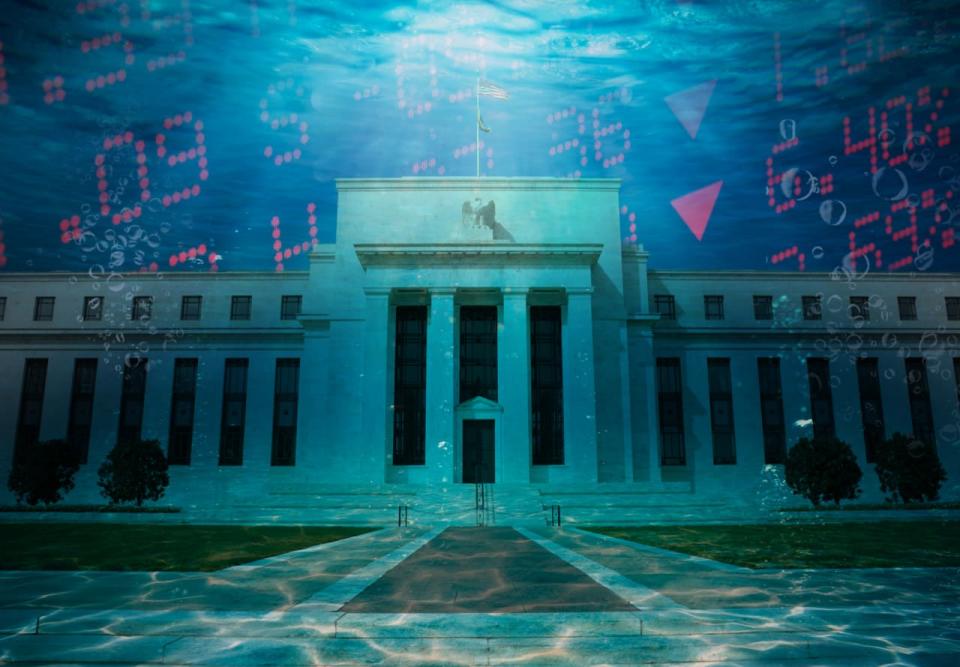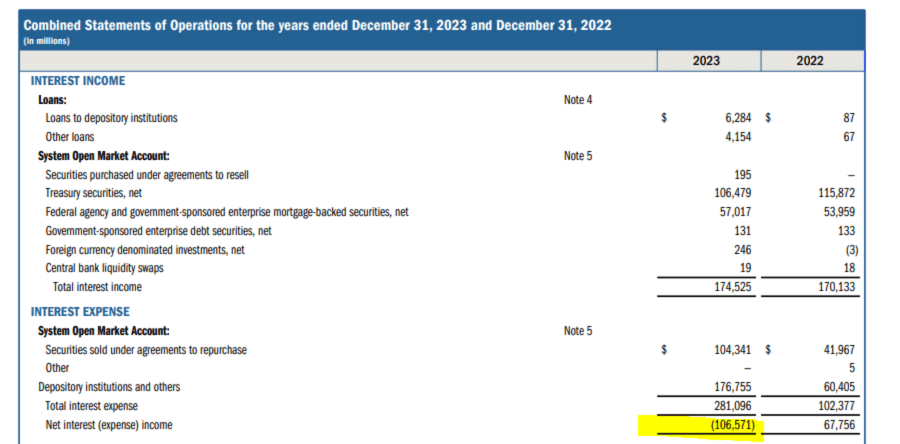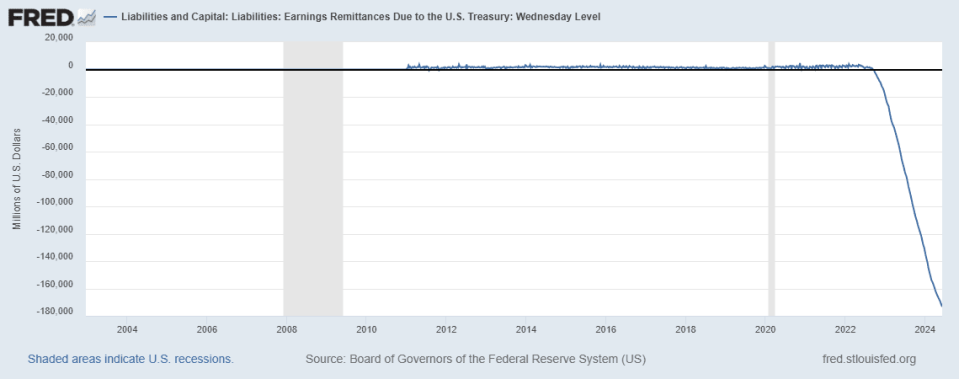

The Federal Reserve’s roughly $1 trillion pile of paper losses stemming from its underwater securities holdings have begun to turn into more than $100 billion in actual losses, with no relief in sight.
Fed Chair Jerome Powell on Wednesday said that easing inflation still isn’t yet near enough to the central bank’s 2% yearly target for interest rates to be lowered from a two-decade high.
Most Read from MarketWatch
The longer rates stay high, however, the harder it will be for the Fed to repair its balance sheet. Importantly, restrictive rates also could end up costing the Fed around $100 billion a year well into the next decade, according to Ali Meli, chief investment officer of Monachil Capital Partners, a credit fund he founded in 2019.
Meli arrived at that estimate by digging through the Fed’s financial statements, which showed a $948.4 billion unrealized loss at the end of 2023 on assets bought on the open market, compared with more than $1 trillion of unrealized losses at the end of 2022.
How did the Fed get here? The central bank aggressively used its balance sheet during the 2007-2009 financial crisis and the 2020 COVID-19 market panic to sop up bonds that otherwise would have been in the portfolios of asset managers, 401(k)s and other investment vehicles.
Doing so helped stabilize shaky financial markets, but it also came with costs. An expansion of the balance sheet can also go too far, propping up demand for risky assets, like stocks and crypto, while stoking inflation that hits wage earners the most.
Before striking out on his own, Meli previously spent 15 years at Goldman Sachs’s global structured-finance group, a stint that included helping the bank design a tactical short on the housing market through monoline insurance companies before the 2008 collapse.
To help tally the costs of the Fed’s pandemic-era support, Meli tracked the central bank’s interest expenses, which have been climbing since last year. Interest expenses were positive at nearly $68 billion in 2022, but last year accounted for the bulk of its $114.3 billion loss reported in March.

“The Fed bailed out Wall Street,” Meli said, pointing to the heaps of long-duration 2% and 3% Treasury and mortgage bonds bought by the Fed during the COVID crisis. Now it is underwater, as it also must finance its operations at its current 5.25% to 5.5% policy rate.
“If they had cut their balance sheet before increasing rates, they wouldn’t have had as big of losses,” Meli said. “But maybe they should not have expanded it as much as they did in 2020.”
Tracking Fed losses
Since the Fed must remit any profit it earns back to the Treasury, another way to track its shortfall is through this chart, which shows remittances turning negative recently — with the hole last pegged at around $170 billion.

Lower rates could help repair some of the paper losses in the Fed’s portfolio.
“If we are talking about unrealized losses, it doesn’t represent a major problem for markets, so long as the Fed’s solvency doesn’t get called into question,” said Danny Zaid, a bond-portfolio manager at TwentyFour Asset Management.
In a recent twist, Sen. Mike Lee, a Utah Republican, introduced a bill that would abolish the Federal Reserve, a companion bill to one from Kentucky Republican Thomas Massie in the House.
Currently, the Fed — unlike an underwater bank facing a run on its deposits — faces no threat of resorting to forced asset sales, which would crystallize losses.
At the end of the day, the Fed can resume using its printing machine to cover its losses, Zaid noted. “I know the numbers sound big — and I think long term, they will affect monetary policy and Fed action,” he said.
Zaid also thinks the Fed would again step in to support wobbly markets if more instability cropped up, including at regional banks.
Related: Moody’s puts several U.S. regional banks on downgrade review over commercial real-estate concerns
“The issues, especially around commercial real estate and regional banks — that’s a problem that’s still there,” he said.
Election risks
The U.S. central bank has been shrinking its balance sheet from a nearly $9 trillion peak by letting some bonds mature each month, without reinvesting the proceeds. The process was slowed starting in June, as the Fed attempts to tighten financial conditions without triggering a recession or shocks to the financial system.
In the past, the Fed made money on assets it bought to help stabilize the economy and financial markets. Older Treasurys with higher yields became more valuable — and scarce — when the central bank cut interest rates in 2007 as the global financial crisis was unfolding, especially as rates were kept low for the following 15 years.
But the COVID era has played out very different, with the Fed buying up trillions of dollars of low-yielding Treasurys and agency mortgage bonds, which became worth less, not more, when the central bank hiked rates.
While many view the Fed’s expanded balance sheet as being an inflationary force, it also bolstered the economy by keeping credit cheap and abundant BX:TMUBMUSD10Y for businesses and households. Most homeowners refinanced at 30-year fixed-rate mortgages below 4%.
“I don’t think it matters, until it matters,” said George Catrambone, head of Americas trading at DWS Group, of the Fed’s large and underwater balance sheet. “If you do find that soft landing, it proves it was just enough.”
Forecasters still expect the Fed’s balance sheet to stabilize in this cycle at around $7 trillion, to help ensure liquidity in financial markets.
But on days that bring more resilient U.S. economic data, investors tend to focus on higher-for-longer rates, climbing debt-service costs and deficit spending, Catrambone said, pointing to the choppy backdrop for Treasury auctions over roughly the last 18 months. “The narrative boomerangs back to that.”
Catrambone also thinks potential U.S. political risks tied to November’s election may be underpriced, especially after France President Emmanuel Macron called for a snap election in a bid to thwart the rise of the nation’s far-right party.
Should a “red wave” take hold, giving Republicans a sweep of both the White House and Congress, he sees risks from the Trump-era tax cuts being extended, instead of sunsetting as expected.
“That makes the fiscal picture more challenging,” Catrambone said.
Read next: Cost of Trump tax cuts soars 50% amid ‘abuse’ of business loopholes
Greg Robb in Washington contributed reporting .
Most Read from MarketWatch
EMEA Tribune is not involved in this news article, it is taken from our partners and or from the News Agencies. Copyright and Credit go to the News Agencies, email news@emeatribune.com Follow our WhatsApp verified Channel









